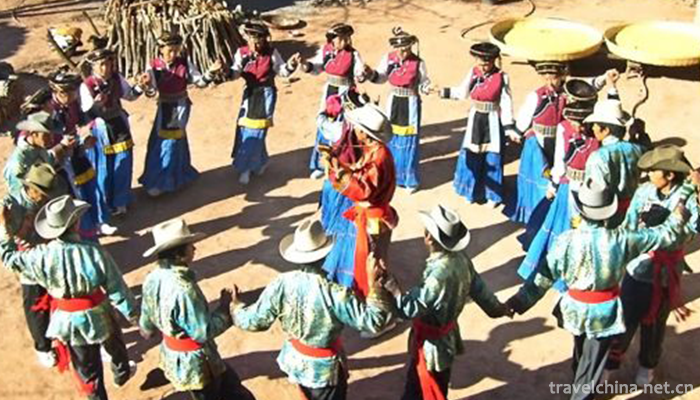Pumi rubbing
Pumi nationality rubbing "rubbing consultation" is Pumi language, "rubbing" means dancing, "rubbing" means dancing, that is, dancing. When dancing, the leader strikes the sheepskin according to a certain rhythm, playing the effect of drumming, so it is also called "sheepskin dance". In addition, there is also the name of "four-string dance" or "Pumi Guozhuang". Mainly spread in Tongdian, Hexi, Lajing, Jinding and Shideng villages where Pumi people live together.
On June 7, 2006, "Pumi rubbing" declared by Lanping Bai Autonomous County of Yunnan Province was included in the second batch of national intangible cultural heritage list.
Heritage serial number: 675 III-78.
historical origin
The origin of "rubbing" can not be traced to history. Folklore tells us that in a war, the Pumi ancestors lit bonfires at night and danced "rubbing" all night long, which made the enemy mistake them for numerous people and horses, and eventually withdrew from the enemy. According to the old artists, the traditional "rubbing" dance has 72 tunes, i.e. 72 sets of changes in dance steps, but only 12 sets of "reunion dance", "bowl chopsticks dance", "similar dance", "shoe-sole dance", "arm-to-arm dance" and "end dance" remain.
artistic characteristics
artistic form
There are twelve sets of rubbing and negotiating dances, but after a long period of circulation, dancing steps have developed everywhere, and different dancing steps are increasing day by day. Nevertheless, there are many similarities and differences in expressive techniques, and the sound type and rhythm are basically fixed. This is a description of the twelve sets of dance steps in Longtang, Tongdian and Waterfront before the 1960s. Its main characteristics are: the force of stamping is vertical (focus on the forefoot of the center of gravity), the force of striding (walking) is horizontal (force point in the crotch), forward bending when regression, reverse upper and lower body strength, backward (natural) when upward and forward, reverse upper and lower body strength (force point in the abdomen position). The representative programs of vertical relationship are "Dengbu Langla" (one foot and two feet); the representative programs of horizontal relationship are "steep worship needs Xu Zhi" (hip-to-hip dance); and the representative programs of opposite force (upper and lower body) are the first dance method of "synthesize" (reunion dance).
The speed is generally medium. When the speed is slow, the dance steps are light and sprinkled, as if the breeze is rhythmically affecting the dress. When the speed increases, the dance steps are rough and powerful.
Formation, mainly (hand in hand) single circle, double circle and half circle, generally used to jump counterclockwise, but also clockwise. If a double circle is formed, jumps in the same direction and in different directions can be made. Dancing is not limited by time, place and number. People who participate in dancing can intervene at any time, or start one after another. Some people can dance and others can sing (folk songs) as they walk. After singing, they danced.
Artistic Characteristics
The "rubbing" dance retains the characteristics of the trinity of ancient songs, dances and music. It has a variety of names, varied formations and steps, with relaxation and relaxation. It is the Pumi people's favorite dance, widely spread, mostly used in various self-entertainment, festive fitness activities, not limited by the number of participants, few dozens of people participate, more than tens of thousands of people can dance together, to express national unity and joy, has a certain artistry.
Inheritance Significance
"Rubbing" is a happy folk dance symbolizing unity, friendship, auspiciousness and happiness. It is popular with the Pumi people and the surrounding ethnic groups, and has created a high reputation in China. Its basic contents and forms are as follows: accompanied by a four-string harp, a dancer taps the wrapped sheepskin in rhythm and produces rhythmic music accompanied by the change of dance steps. The artistic creation of "Dragon Opening Door", "Dragon Out of Water", "Dragon Turning over", "Dragon Drilling Hole", "Dragon Swinging Tail", "Dragon Holding Column", "Dragon Closing Door" and "Dragon Happiness" is twisted and twisted. Type I, team type changes quickly and smoothly, vigorous and lively, momentum, a thousand miles.

0 Questions
Ask a Question
Your email address will not be published.